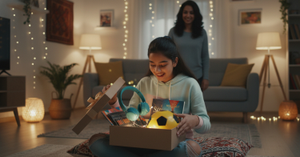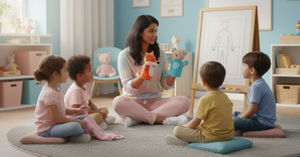“The senses, being the explorers of the world, open the way to knowledge.” – Maria Montessori.
Have you ever watched a child try a lemon for the first time, the way their face crinkles in surprise? Or how they reach for their favourite food with wide eyes and a happy smile? Every time we eat, our taste buds are quietly doing their work, helping us explore the world through flavour.
But do children know how they perceive the taste of things? What makes a mango sweet or a green chilli spicy? Where on the tongue do these sensations happen? And how are taste and smell connected?
Enter the world of Taste Bud Adventures, a gentle science project that turns your home into a flavour lab and your child into a curious explorer. It’s not just an experiment, it’s a playful discovery of how the body senses, responds, and enjoys.
A Journey Through Taste: Why This Project Matters
In a world where food is often hurried, packaged, or eaten in front of screens, it’s easy to forget the magic behind each bite. But when we pause and pay attention to what we’re tasting, something beautiful happens: we reconnect with our senses, and children learn to trust and appreciate their bodies.
The Taste Bud Adventures project offers just that: a pause, a play, and a purpose. It helps children become more aware of what they eat, how they feel, and how their bodies react. This awareness lays the foundation for mindful eating, sensory intelligence, and even emotional regulation.
It also opens the door to conversations about nutrition, culture, health, and diversity, because food is not just science; it’s also a story, a memory, and an identity.
What Are Taste Buds, Really?
Our tongue is a small but powerful sensory organ. It’s home to thousands of taste buds, tiny clusters of receptor cells that respond to different flavour molecules. When we eat, these cells send signals to the brain, which interprets them as:
- Sweet (like fruit or sugar)
- Sour (like lemon or tamarind)
- Salty (like chips or pickles)
- Bitter (like coffee or leafy greens)
- Umami (a savory taste found in tomatoes, cheese, or soy sauce)
Contrary to old belief, these tastes aren’t located on separate parts of the tongue; every taste bud can sense all types of flavours, though some areas may be slightly more sensitive.
Taste buds also change with age. Children often have more taste buds than adults, which is why certain foods feel “too strong” to them. Helping them explore flavors in a safe and fun way can gently expand their palate without pressure.
The Taste Bud Adventures DIY Activity
Here’s how you can set up a simple, delightful science experiment with your child using everyday kitchen ingredients. You’ll need:
- A blindfold (scarf or handkerchief)
- Small samples of different tasting items like:
Start by gently blindfolding your child (if they’re comfortable) and offering small tastes, one at a time. Ask them:
- “Can you guess what taste it is?”
- “How does it feel in your mouth—sharp, smooth, warm?”
- “What emotion or memory does this taste remind you of?”
It’s amazing how the absence of sight strengthens the other senses. Children might notice textures, temperatures, or flavours they’d usually miss.
For a variation, you can pinch the nose while tasting, which demonstrates how taste and smell work together. Without the sense of smell, many flavours become dull or indistinct. It’s a powerful way to explain the profound interconnectedness of our senses.
What Kids Learn Through This Activity
This playful adventure is more than just fun; it’s filled with rich lessons:
1. Sensory Awareness
Children learn to notice subtle differences between flavours. They become curious, rather than picky, eaters.
2. Scientific Curiosity
They begin to ask, “Why” specific tastes feel stronger or linger longer. It introduces biology in a relatable, hands-on way.
3. Emotional Vocabulary
Tastes are linked to feelings. Through this, children can better describe what they enjoy or dislike, and why. That’s a big step in self-expression.
4. Appreciation for Food
By slowing down and tasting mindfully, children understand that food is not just fuel, it’s flavour, feeling, and connection.
Exploring With Heart and Humour
There’s laughter in every sour surprise and joy in every “Yum!” moment. As your child experiments, be their co-adventurer. Taste with them. Compare reactions. Create a little “taste diary” with smiley faces, words, or drawings.
You can even link tastes with different cultures:
- “This is bitter gourd—many people in India use it in sabzis.”
- “Soy sauce is salty and umami—often used in Asian cuisines.”
- “Sweet and sour chutneys are part of our festivals.”
Food becomes a language, a storybook, a passport. And suddenly, science feels deeply human.
A Gentle Note About Differences
Every child is unique. Some may be sensitive to particular tastes or smells, and that’s okay. Don’t push or force. Instead, invite. Let the experience be led by curiosity, not pressure. Some kids may try just one taste; others may ask for more rounds.
The goal is not to “train” a child to eat everything, but to let them understand their body’s signals and honour their preferences with awareness and confidence.
Taste Buds and Health
There’s also a gentle medical truth behind this activity. Healthy taste buds are often linked with:
- Proper hydration
- Balanced oral hygiene
- Avoiding too much sugar or salt
- A varied, colorful diet
If a child frequently complains of bland food or shows sudden disinterest in taste, it can occasionally signal issues such as zinc deficiency, mouth ulcers, or infections. Awareness helps. Taste Bud Adventures can be a window into their health, too.
A Final Thought
Taste Bud Adventures isn’t just a science project; it’s a sensory celebration. A way to slow down and savour. To reconnect with curiosity. To build healthy, lifelong relationships with food, feelings, and the body.
So gather the flavours, sit at the kitchen table, and let the exploration begin. There’s so much joy in that tiny moment when a child says, “Oh! That’s salty!” with delight.
Because in that moment, they’re not just learning, they’re awakening.
And the body, after all, is the first classroom we ever know.








Be the first one to comment on this story.